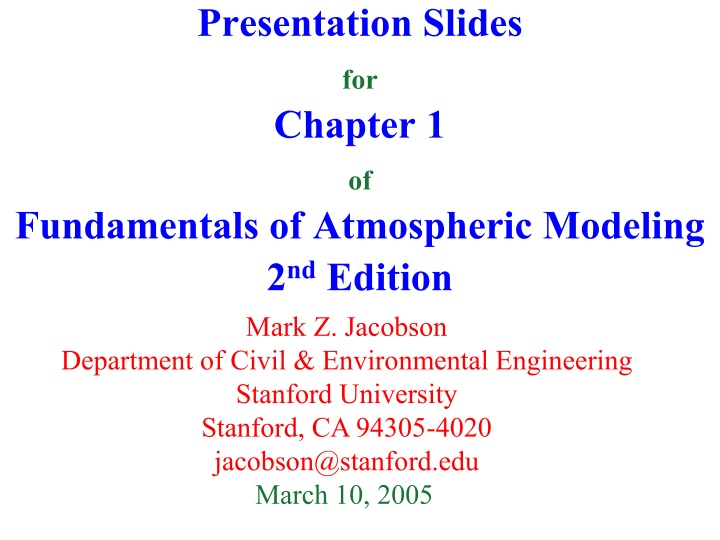
Fundamentals of Atmospheric Modeling: Chapter 1 Insights
Explore the historical evolution of meteorology, from Aristotle's teachings to modern atmospheric modeling techniques. Delve into the scales of motion and atmospheric processes shaping our understanding of weather phenomena. Gain insights into gas processes, aerosol dynamics, and more.
Download Presentation

Please find below an Image/Link to download the presentation.
The content on the website is provided AS IS for your information and personal use only. It may not be sold, licensed, or shared on other websites without obtaining consent from the author. If you encounter any issues during the download, it is possible that the publisher has removed the file from their server.
You are allowed to download the files provided on this website for personal or commercial use, subject to the condition that they are used lawfully. All files are the property of their respective owners.
The content on the website is provided AS IS for your information and personal use only. It may not be sold, licensed, or shared on other websites without obtaining consent from the author.
E N D
Presentation Transcript
Presentation Slides for Chapter 1 of Fundamentals of Atmospheric Modeling 2ndEdition Mark Z. Jacobson Department of Civil & Environmental Engineering Stanford University Stanford, CA 94305-4020 jacobson@stanford.edu March 10, 2005
Brief History of Meteorology 1800's Three-cell model - Ferrel (1855) Weather maps of surface pressure 1900's Weather prediction from maps - Bjerknes (1903) Polar front theory - Bjerknes (1921) Numerical weather prediction - Richardson (1922) First computer forecast - Charney / von Neumann (1948) Daily balloon observations (1940's) Weather satellites (Tiros I, 1960) 340 B.C. Meteorologica - Aristotle 1400's Hygrometer - Cryfts (1450) Anemometer - Alberti (1450) 1500's Thermoscope - Galileo 1600's Barometer - Torricelli (1643) Les Meteores - Descarte (1637) 1700's Trade winds - Hadley (1730)
Excerpts from Aristotle s Meteorologica There are two reasons for there being more winds from the northerly than the southerly regions. First, our inhabited region lies toward the north; second, far more rain and snow is pushed up into this region because the other lies beneath the sun and its course. These melt and are absorbed by the earth and when subsequently heated by the sun and the earth s own heat cause a greater and more extensive exhalation. Let us now explain lightning and thunder, and then whirlwinds, firewinds and thunderbolts; for the cause of all of them must be assumed to be the same. As we have said, there are two kinds of exhalation, moist and dry; and their combination (air) contains both potentially. It condenses into cloud, as we have explained before, and the condensation of clouds is thicker toward their farther limit. Heat when radiated disperses into the upper region. But any of the dry exhalation that gets trapped when the air is in process of cooling is forcibly ejected as the clouds condense and in its course strikes the surrounding clouds, and the noise caused by the impact is what we call thunder.
Scales of Motion (Table 1.1) Molecular scale (<< 2 mm) Molecular diffusion Molecular viscosity Microscale (2 mm- 2 km) Eddies Small plumes Car exhaust Cumulus clouds Mesoscale (2 - 2000 km) Gravity waves Thunderstorms Tornados Local winds Urban air pollution Synoptic scale (500-10,000 km) Pressure systems Weather fronts Tropical storms Hurricanes Antarctic ozone hole Planetary scale (>10,000 km) Global wind systems Rossby waves Stratospheric ozone loss Global warming
Atmospheric Model Gas processes Emission Photochemistry Gas-to-particle conversion Cloud removal Aerosol processes Emission Nucleation/condensation Aerosol, cloud coagulation Dissolution/chemistry/crystallization Dry deposition/sedimentation Rainout/washout Cloud processes Activation on aerosol Conden./evap./deposition/sublim. Hom./het./contact/evap. freezing Cloud, aerosol coagulation Precipitation/lightning Dissolution/chemistry Radiative transfer UV/visible/near-IR/thermal-IR Scattering/absorption Gas Snow, ice, water albedos Meteorological processes Velocity Pressure Temperature Density Turbulence Surface processes Temperatures and water content of Soil Water Sea ice Vegetation Roads Roofs Surface energy/moisture fluxes Ocean-atmosphere exchange Ocean dynamics, chemistry Aerosol Hydrometeor Geopotential Water vapor Snow Fig. 1.1
